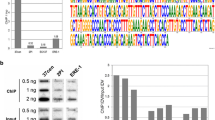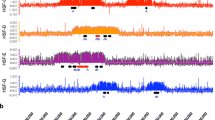Abstract
Genomic databases do not contain complete sequences of the centromeric regions. We created a pUC19-based library of DNA fragments from isolated chromocentres of interphase nuclei. In this library we have found major satellite (MaSat)and two new satellite sequences - MS3 and MS4. The computer analysis of MS3 and MS4 sequences by alignment, fragment curved state and search for MAR motifs in comparison with the mouse major and minor satellite (MiSat)DNA has shown them to be new satellite fragments. Southern blot of MS3 and MS4 with total DNA digested by restriction enzymes shows the ladder characteristic of satellite DNA. 2.2% of the total DNA consists of MS3, the monomer of which is 150 bp long. The MS4 monomer is 300 bp long and accounts for 1.6% of the total DNA. On metaphase chromosomes MS3 and MS4 are located at the centromeric region. FISH analysis of L929 nuclei during the cell cycle showed relative positions of MaSat, MiSat, MS3, and MS4. All mapped satDNA fragments except MaSat belong to the outer layer of the chromocentres in the G0/G1 phase. MS3 is likely to be involved in the centromere formation. The mouse genome contains at least four satDNA types: AT-rich (MaSat and MiSat), and CG-rich (MS3 and MS4).
Similar content being viewed by others
Author information
Authors and Affiliations
Corresponding author
Rights and permissions
About this article
Cite this article
Kuznetsova, I.S., Prusov, A.N., Enukashvily, N.I. et al. New types of mouse centromeric satellite DNAs. Chromosome Res 13, 9–25 (2005). https://doi.org/10.1007/s10577-005-2346-x
Received:
Revised:
Accepted:
Issue Date:
DOI: https://doi.org/10.1007/s10577-005-2346-x




